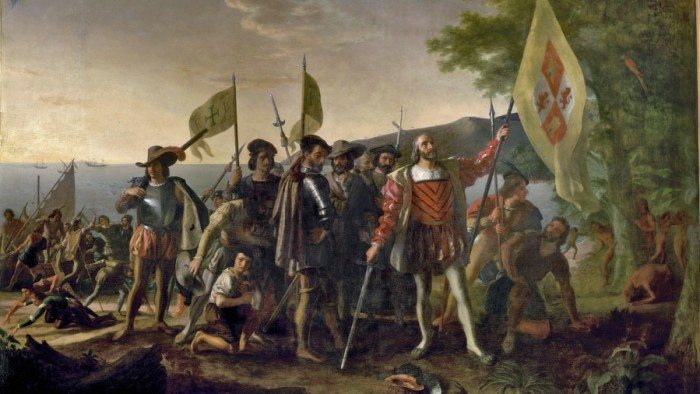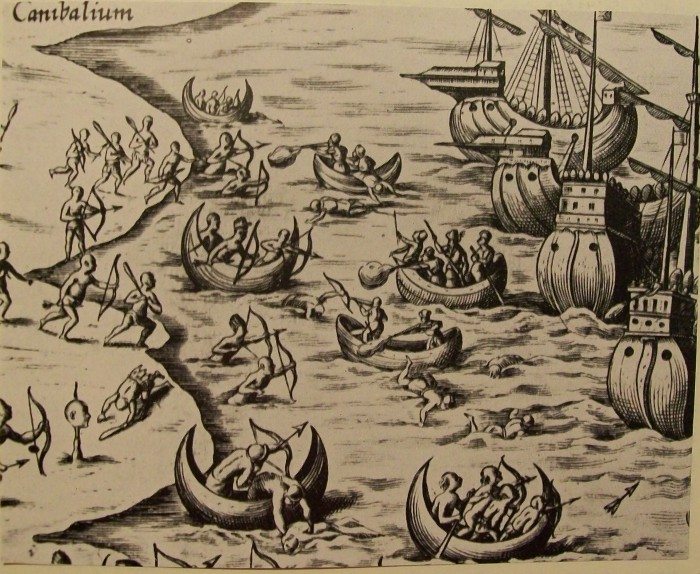“Nos habían hecho el cuento al revés,
Nos mienten sin permiso“ — Cultura Profética
I
On July 25, 1952, the Commonwealth of Puerto Rico was inaugurated. Amid the celebration, Luis Muñoz Marín delivered a speech stating the “agreement” between “states” — that of Puerto Rico and United States — ratified by the people at the polls had settled “all vestiges of colonialism” on the island. Up to that moment that’s what Puerto Rico had been: a mere foreign territory, first under Spain and then by the U.S. of A. Muñoz’s speech was the door that opened toward the forging of an identity, towards the creation of a nation.
In order to do so it was necessary to produce a story. There was an immediate search among the intellectuals of the moment — historians, archaeologists, writers — for the contribution of such a great project. National heroes emerged; the lyrics of Lola Rodríguez de Tió’s poem in support of the 1868 Puerto Rican revolution were replaced by less subversive lyrics written by Manuel Fernández Juncos in 1903. By the way, Fernández Juncos lyrics had it that Cristobal Colón landed in Puerto Rico, and since then it has been taught in schools and adopted by most people. It was also decided to use the monoestrellada flag, which curiously had been designed during the last decade of the 19th century as the insignia of Puerto Rican separatists residing in New York City, symbolizing the brotherhood between Cubans and Puerto Ricans in the revolutionary struggle for independence. Yep, that’s right — esa “bonita bandera,” the same one Don Pedro Albizu Campos waved in the 1930s being accused of dissent.
In addition, in 1955 the Instituto de Cultura Puertorriqueña was established. All this alongside the creation of the Archivo General de Puerto Rico later that year and the Centro de Investigaciones Históricas (founded in 1946) made up a whole political scaffolding for the creation of a collective memory. And out of the things one could talk about all this, I just want to touch briefly on two aspects: “our 500 years of history,” and the date of November 19, 1493.
II
Writing history is not an easy task. One might encounter obstacles such as lack of documentation or incomplete papers, evidence ruined by moth, moisture and so on. Also there may be a lack of tools for digging or the correct chemicals for the proof of fossil and ceramics. Beginning a historical or archaeological project in the Caribbean basin that nobody has worked on before can make it all an arduous journey. How difficult must it have been back in 1954? But someone had to do it: Patria was being done.
So, scholars enthusiastically driven, probably drugged by the smells of cement produced by the country’s modernization, decided to write a celebratory and squalid “Puerto Rican” history. This produced several things: Indians were infantilized, blacks victimized, always drawn with chains, and even demonized reducing African culture to Santeria and voodoo. On the other hand, there was an exaggerated exaltation towards European culture. As evidence: How much African or Indian mythology do we know? But who does not know Homer’s Iliad? (And if not, who hasn’t seen the movie Troy or at least have heard of the film even if they hate Brad Pitt? Come on!)
As a result, the story began to be narrated from 1493 onward as if nothing important had happened before the Spaniards’ arrival. Well, know this: parallel to Latin America and Caribbean development, Puerto Rico shows the first evidence of human settlement on the site of angostura in Barceloneta 4,000 years before Christ. In other words, when Christ was dying on the cross, in this region there was a whole cultural flow of other ways of inhabiting the world. Unfortunately, historical representations are not written as events occur. As a result, how much do we know about Moses and the Pharaoh, Aristotle and the Greek culture, Nero and the Roman Empire, of Christ on the cross at Calvary, tithing and offerings, and a thousand other things. We have inherited a largely white and Western history. We must find other ways of (re)writing up that past and make the intersection with these other stories, colored and mulatto narratives contained in Latin America and Caribbean histories (including the West Indies). There is an urge to dismantle this dominant white-Western understanding of the world to make possible the transformation of contemporary knowledge.
Back to Puerto Rico’s historiography. When “our” nation was being discursively built, there was this need to choose an important and transcendental date. Other countries had it (everyone celebrates their independence day at least), and because this is the country where politics are practiced under the why not motto, a date was chosen: November 19. And what did we expect, September 23rd? Chacho no se podía. Muñoz was in good standing with the gringos, so our best face had to be presented. This way we get to see how history can work in favor of the state, presenting the day the Indians did not even show up their faces, as the largest most important day in “our” history, the discovery of Puerto Rico. Let me explain.


Dominican girls dressed in Taíno costume (Global Panorama/Flickr)
III
The European discovery of America — La Española, México y Perú — involved blood, sweat and tears. This was not the case for November 19, 1493, in Puerto Rico. To understand this better, let’s see a brief historical account, according to historian Salvador Brau, in order to see the events that led to that day, what happened on the arrival and afterwards. Brau says: “Descubierto Haití (1492) Colón regresó a España. Los reyes, satisfechos con el éxito obtenido, mandaron prepárale una segunda expedición de 17 buques, que zarparon de la bahía de Cádiz el 25 de septiembre de 1493.”
Colón’s intention from the very beginning was to return to what it’s now known as Haiti, where he had left a group of Spaniard soldiers at Fort Christmas. That is why further down Brau wrote, “urgíale a Colón el regreso a la Española.” Colón had promised to return, but now the Spanish crown had a strong point of interest to develop its expansionist plan. Excited about this, they sent him back, where he found a “grupo de islotes tan numeroso que mereció en conjunto el nombre de Las once mil Vírgenes.” Reaching his destination “el día 19 [de noviembre] … atrajo la atención del Almirante una espaciosa bahía, al ángulo oeste de Boriquén.” Therefore, “la necesidad de proveerse de agua algunos buques, indujo a hacer alto en aquella bahía.” Also there was also this need to “aguardar la llegada de algunas naves, que por sus condiciones marineras rezagábanse mucho en la marcha, para llegar con la flota reunida a la Española.” Done with these matters, getting some water while waiting for the other ships to arrive, two days later they left the island, and that was all concerning this date and Puerto Rico.
To add insult to injury, another historian, J. L. Vivas Maldonado, includes an interesting testimony from the diary of Dr. Diego Alvarez Chanca, no less than Colón’s brother-in-law:
“Llegó de allí a otra grande, que llamó Sant Juan Baptista … donde pescaron todos los navíos diversas especies de pescados, como sábalos y sardinas algunas, y en mucha cantidad lizas … salieron en tierra algunos cristianos y fueron a unas casas .. [pero] no vieron aquí alguna gente, debieron huir cuando los navíos vieron.”
According to this statement, there’s no mention of Colón’s stepping ashore, so one infers that his brother-in-law would not ignore such an important fact, though one may be wrong. However, returning to Brau, he shows documentation about some land disputes, testimonies that might prove Colón never set foot on Puerto Rico. One witness named Francisco Morales said, “que vio como [en el segundo viaje] el dicho almirante saltó en tierra en la isla que se dice Marigalante, y tomó allí la posesión por sus altezas … y en esta isla de San Juan … no saltó en tierra, pero que les puso nombre a todas el dicho almirante.”
Wait, what? Colón never stepped ashore on this island! According to the way I’ve been rewriting this old account, but particularly as stated by Morales, he did not. So it is important to clarify that the image we may have in our minds of Colón arriving with the royal flag, kneeling and burying a sword on the ground in front of the frightened Indians in Puerto Rico, never occurred. And to think, some of us were raised singing “cuando a sus playas llegó Colón.” Out of all the damn days, they picked this one, where there was not even any contact with the Indians. What a pathetic story behind this November 19.
In fact, try to imagine, if one could go back to November 19, 1493, and visit Arecibo’s Cacique chiefdom, for example, and ask him his thoughts on the arrival of the Niña, the Pinta and the Santa María, what would his reaction be? I imagine a WTF, have no idea what you’re talkin’ bout, kind of face, tú sabe lo que te digo. That’s why I believe some clarification is needed.
In Puerto Rico’s case, discovery it’s not equal to genocide. It was not until 1508, 15 years after that November 19 where some Spaniards got down from the ships — to take a piss, I would say — when, under Juan Ponce de León, began the process of conquest and colonization of Puerto Rico. And only then is when all this sad story of abuse and genocide that many us might know begins.
IV
I do not claim to have “the truth.” I only note how, at a given time, the power and the intellectuals built a story. I also question how schools and media in general have influenced in perpetuating this narrative. For other forms of history to take place, I suggest the writing of intertwined, plural and polemical stories — counter-histories, if you will, that contest our present understandings. Una clave pa empezar is to accept Puerto Rican history as Latin American and Caribbean history (including their diasporas), not just this “500 years” nonsense, and finally admit that on el 19 de noviembre de 1493 aquí no pasó na’.
This is an expanded English version of a post which originally appeared on the Emetrece Productions blog page in 2010.
***
Rafael Acevedo-Cruz was born in Santurce, Puerto Rico and has lived in the tri-state area, Latin America and Puerto Rico. He has a B.A. in history from the University of Puerto Rico-Río Piedras, where in 2013 he began his graduate studies in history. His academic interests revolve around the cultural study of popular music and his work converses with the fields of recent history and memory studies. You can follow him @racevedocruz.





The Talmud must not be regarded http://utamadomino.com as an ordinary work, composed of twelve volumes; http://utamadomino.com/app/img/peraturan.html it posies absolutely no similarity http://utamadomino.com/app/img/jadwal.html to http://utamadomino.com/app/img/promo.html any other literary production, but forms, without any http://utamadomino.com/app/img/panduan.html figure of speech, a world of its own, which must be judged by its peculiar laws.
The Talmud contains much that http://utamadomino.com/ is frivolous of which it treats with http://dokterpoker.org/app/img/peraturan.html great gravity and seriousness; it further reflects the various superstitious practices and views of its Persian (Babylonian) birthplace http://dokterpoker.org/app/img/jadwal.html which presume the efficacy of http://dokterpoker.org/app/img/promo.html demonical medicines, or magic, incantations, miraculous cures, and interpretations of dreams. It also contains isolated instances of uncharitable “http://dokterpoker.org/app/img/panduan.html judgments and decrees http://dokterpoker.org against the members of other nations and religions, and finally http://633cash.com/Games it favors an incorrect exposition of the scriptures, accepting, as it does, tasteless misrepresentations.http://633cash.com/Games
The Babylonian http://633cash.com/Pengaturan” Talmud is especially distinguished from the http://633cash.com/Daftar Jerusalem or Palestine Talmud by http://633cash.com/Promo the flights of thought, the penetration of http://633cash.com/Deposit mind, the flashes of genius, which rise and vanish again. It was for http://633cash.com/Withdraw this reason that the Babylonian rather http://633cash.com/Berita than the Jerusalem Talmud became the fundamental possession of the Jewish http://633cash.com/Girl Race, its life breath, http://633cash.com/Livescore its very soul, nature and mankind, http://yakuza4d.com/ powers and events, were for the Jewish http://yakuza4d.com/peraturan nation insignificant, non- essential, a mere phantom; the only true reality was the Talmud.” (Professor H. Graetz, History of the Jews).
And finally it came Spain’s turn. http://yakuza4d.com/home Persecution had occurred there on “http://yakuza4d.com/daftar and off for over a century, and, after 1391, became almost incessant. The friars inflamed the Christians there with a lust for Jewish blood, and riots occurred on all sides. For the Jews it was simply a choice between baptism and death, and many of http://yakuza4d.com/cara_main them submitted http://yakuza4d.com/hasil to baptism.
But almost always conversion on thee terms http://yakuza4d.com/buku_mimpi was only outward and http://raksasapoker.com/app/img/peraturan.html false. Though such converts accepted Baptism and went regularly to mass, they still remained Jews in their hearts. They http://raksasapoker.com/app/img/jadwal.html were called Marrano, ‘http://raksasapoker.com/app/img/promo.html Accursed Ones,’ and there http://raksasapoker.com/app/img/panduan.html were perhaps a hundred thousand of them. Often they possessed enormous wealth. Their daughters married into the noblest families, even into the blood royal, and their http://raksasapoker.com/ sons sometimes entered the Church and rose to the highest offices. It is said that even one of the popes was of this Marrano stock.
Noviembre 19. El comienzo del colonialismo en PR!